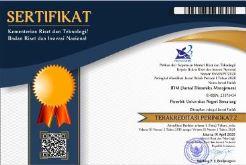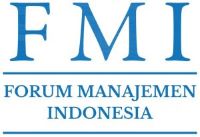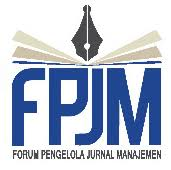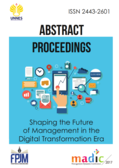Information Technology as a Strategic Resource in Encouraging Organizational Change Readiness through the Role of the Human Capital Effectiveness
Abstract
Keywords
Full Text:
PDFReferences
Abd Razak, N., Rashid. W. E. W., & Yunus, N. A. M. (2014). An Integrated Infrastructure Capabilities of Knowledge Transfer. Proceedings. Paper presented at the Knowledge Management International Conference (KMICe), 12-15 August, Langkawi.
Adil, M. S. (2016). Impact of Change Readiness on Commitment to Technological Change, Focal, and Discretionary Behaviors. Journal of Organizational Change Management, 29(2), 222-241.
Alaarj, S., Abidin-Mohamed, Z., & Bustamam, U. S. B. A. (2016). Mediating Role of Trust on the Effects of Knowledge Management Capabilities on Organizational Performance. Procedia-Social and Behavioral Sciences, 235(1), 729-738.
Alireza, J., Mastura, J., & Thurasamy, R. (2014). Entrepreneurial Orientation and Performance: the Interaction Effect of Customer Capital. World Journal of Entrepreneurship, Management and Sustainable Development, 10(1), 48-68.
Andaleeb, S. S., Rashid, M., & Rahman, Q. A. (2016). A Model of Customer-Centric Banking Practices for Corporate Clients in Bangladesh. International Journal of Bank Marketing, 34(4), 458-475.
Anyaoku, E. N., Osuigwe, N. E., & Oguaka, C. N. (2015). Technology and Job Satisfaction in Academic Libraries: Role of Leadership Style and Librarians’ Attitude. International Journal of Library Science, 4(4), 73-80.
Apriyanto, R. D., & Putro, H. P. (2018). Tingkat Kegagalan dan Keberhasilan Proyek Sistem Informasi di Indonesia. Proceedings. Seminar Nasional Teknologi Informasi dan Komunikasi (SENTIKA). 23-24 March, Yogyakarta.
Baron, A. (2011). Measuring Human Capital. Strategic HR Review, 10(2), 30-35.
Bijoylaxmi, S., Zillur, R., & Shampy, K. (2017). Customer Co-creation and Adoption Intention towards Newly Developed Services: an Empirical Study. International Journal of Culture, Tourism and Hospitality Research, 11(3), 372-391.
Bono, J. E., & Anderson, M. H. (2005). The Advice and Influence Networks of Transformational Leaders. Journal of Applied Psychology, 90(6), 1306-1314.
Bontis, N. (2001). Assessing Knowledge Assets: a Review of the Models Used to Measure Intellectual Capital. International Journal of Management Reviews, 3(1), 41-60.
Bontis, N. (2002). There is a Price on Your Head: Managing Intellectual Capital Strategically. Business Quarterly Summer, 96(60), 40-47.
Bontis, N., & Fitz-enz, J. (2002). Intellectual Capital ROI: a Causal Map of Human Capital Antecedents and Consequents. Journal of Intellectual Capital, 3(3), 223-247.
Carmeli, A., Ben-Hador, B., Waldman, D., & Rupp, D. (2009). How Leaders Cultivate Social Capital and Nurture Employee Vigor: Implications for Job Performance. Journal of Applied Psychology, 94(6), 1553-1561.
Chen, L., Zheng, W., Yang, B., & Bai, S. (2016). Transformational Leadership, Social Capital and Organizational Innovation. Leadership & Organization Development Journal, 37(7), 843-859.
Chiu, C. N., & Chen, H. H. (2016). The Study of Knowledge Management Capability and Organizational Effectiveness in Taiwanese Public Utility: the Mediator Role of Organizational Commitment. Springer Plus, 5(1), 1520-1533.
Choo, C. W., & Bontis, N. (2002). The Strategic Management of Intellectual Capital and Organizational Knowledge. Oxford : Oxford University Press.
Ebrahimi, P., Moosavi, S. M., & Chirani, E. (2016). Relationship between Leadership Styles and Organizational Performance by Considering Innovation in Manufacturing Companies of Guilan Province. Procedia-Social and Behavioral Sciences, 230(2016), 351-358.
Fauzie, Y. Y. (2017). Lotus Thamrin Tutup Gerai Susul Ramayana dan Matahari. Available at: cnnindonesia.com/ekonomi/20171022105245-92-250043/lotus-thamrin-tutup-gerai-susul-ramayana-dan-matahari. 30 July 2020.
Foos, T., Schum, G., & Rothenberg, S. (2006). Tacit Knowledge Transfer and the Knowledge Disconnect. Journal of Knowledge Management, 10(1), 6-18.
Ghozali, I. (2008). Model Persamaan Struktural: Konsep dan Aplikasi dengan Program AMOS 16.0. Semarang: Badan Penerbit Universitas Diponegoro.
Gilbert, J. H., Von Ah, D., & Broome, M. E. (2017). Organizational Intellectual Capital and the Role of the Nurse Manager: a Proposed Conceptual Model. Nurs Outlook, 65(6), 697-710.
Glaser, L., Fourné, S. P. L., & Elfring, T. (2015). Achieving Strategic Renewal: the Multi-level Influences of Top and Middle Managers’ Boundary-Spanning. Small Business Economics, 45(2), 1-23.
Goksoy, A. (2014). The Impact of Human Resource Management Practices on Employee Readiness for Change During Mergers and Acquuistions Argumenta Oeconomica Cracoviensia, 2(11), 47-62.
Gold, A. H., Malhotra, A., & Segars, A. H. (2001). Knowledge Management: an Organizational Capabilities Perspective. Journal of Management Information Systems, 18(1), 185-214.
Guerrero, E. G., & Kim, A. (2013). Organizational Structure, Leadership and Readiness for Change and the Implementation of Organizational Cultural Competence in Addiction Health Services. Eval Program Plann, 40(1), 74-81.
Hair, J. F. (2011). Multivariate Data Analysis: an Overview (Seventh Edition ed.). British: Pearson.
Harris, R. J. (2009). Improving Tacit Knowledge Transfer within SMEs through eâ€Collaboration. Journal of European Industrial Training, 33(3), 215-231.
Heavey, C., Mowday, R. T., Kelly, A., & Roche, F. (2009). Reconceptualizing Executive Environmental Scanning and Search: Implications for International Leadership Research and Practice. Advances in Global Leadership, 5(5), 65-92.
Hermawan, I., Sartono, S., & Khakim, L. (2018, August). Entrepreneur Capability in Pekalongan City: Issues of Gender, Local Culture and Anti Plagiation Spirit for Creative Community. Proceedings. E3S Web Conference. Available at : 10.1051/e3sconf/20187310004.
Hermawan, I., Sartono, N. G., & Khakim, L. (2016). Open Innovation on Entrepreneurial Knowledge Intermediation through Social Media Creative Development: a Case Study of Creative Cities in Indonesia. The Social Science, 11(18), 4378-4383.
Hermawan, I., & Tripriyo, V. (2014). Membangun Kinerja Usaha Melalui Faktor Pembentuk Kapabilitas Pelaku Kewirausahaan Industri Kreatif Nasional. Jurnal Ekonomi dan Bisnis, 18(2), 33-52.
Itsekor, L. U. (2018). Mitigating Petroleum Product Shortages in the Nigerian Downstream Petroleum Supply Industry. Doctoral Dissertation. Walden University: Minneapolis.
José, R., Juan, R., & Silvia, S. (2018). Antecedents and Consequences of Knowledge Management Performance: the Role of IT Infrastructure. Intangible Capital, 14(4), 518-535.
Kaushal, S. (2011). Effect of Leadership and Organizational Culture on Information Technology Effectiveness: a review. Proceedings. Paper presented at International Conference on Research and Innovation in Information Systems, Kuala Lumpur, 23-24 November.
Ling, B., Guo, Y., & Chen, D. (2018). Change Leadership and Employees’ Commitment to Change: a Multilevel Motivation Approach. Journal of Personnel Psychology, 17(2), 83-93.
Liu, C. H., Yu, Z. Y., & Tjosvold, D. (2002). Production and People Values: their Impact on Relationships and Leader Effectiveness in China. Leadership & Organization Development Journal, 23(3), 134-144.
Lokuge, S., Sedera, D., Grover, V., & Dongming, X. (2019). Organizational Readiness for Digital Innovation: Development and Empirical Calibration of a Construct. Information & Management, 56(3), 445-461.
Matin, E. K., & Sabagh, P. (2015). Effects of Knowledge Management Capabilities on Organizational Performance in Iranian Export Companies. Mediterranean Journal of Social Sciences, 6(2), 240-240.
Mayer, R. C., Davis, J. H., & Schoorman, F. D. (1995). An Integrative Model Of Organizational Trust. Academy of Management Review, 20(3), 709-734.
Mills, A. M., & Smith, T. A. (2011). Knowledge Management and Organizational Performance: a Decomposed view. Journal of Knowledge Management, 15(1), 156-171.
Mithas, S., & Krishnan, M. S. (2008). Human Capital and Institutional Effects in the Compensation of Information Technology Professionals in the United States. Management Science, 54(3), 415-428.
Ndungu, S., Wanjau, K., Gichira, R., & Mwangi, W. (2017). Moderating Role of Entrepreneurial Orientation on the Relationship between Information Technology Competence and Firm Performance in Kenya. International Journal of Professional Business Review, 2(2), 1-22.
Neves, P. (2009). Readiness for Change: Contributions for Employee's Level of Individual Change and Turnover Intentions. Journal of Change Management, 9(2), 215-231.
Northouse, P. G. (2018). Leadership, Theory and Practice. California: Sage Publications.
Noruzy, A., Dalfard, V. M., Azhdari, B., Nazari-Shirkouhi, S., & Rezazadeh, A. (2013). Relations between Transformational Leadership, Organizational Learning, Knowledge Management, Organizational Innovation, and Organizational Performance: an Empirical Investigation of Manufacturing Firms. The International Journal of Advanced Manufacturing Technology, 64(5-8), 1073-1085.
Nugroho, M. A., Susilo, A. Z., Fajar, M. A., & Rahmawati, D. (2017). Exploratory Study of SMEs Technology Adoption Readiness Factors. Procedia Computer Science, 124(20), 329-336.
Obal, M. (2013). Why do Incumbents Sometimes Succeed? Investigating the Role of Interorganizational Trust on the Adoption of Disruptive Technology. Industrial Marketing Management, 42(6), 900-908.
Parul, M., & Pooja, G. (2017). The Relationship between Learning Culture, Inquiry and Dialogue, Knowledge Sharing Structure and Affective Commitment to Change. Journal of Organizational Change Management, 30(4), 610-631.
Powell, T. C., & Dent, M. (1997). Information Technology as Competitive Advantage: the Role of Human, Business, and Technology Resources. Strategic Management Journal, 18(5), 375-405.
Project Smart. (2014). The Standish Group Report-Chaos Report 2014. Available at : https://www.projectsmart.co.uk/white-papers/chaos-report.pdf. 2 March 2020.
Protogerou, A., Caloghirou, Y., & Vonortas, N. S. (2017). Determinants of Young Firms’ Innovative Performance: Empirical Evidence from Europe. Research Policy, 46(7), 1312-1326.
Rad, A. M. M., & Yarmohammadian, M. H. (2006). A Study of Relationship between Managers' Leadership Style and Employees' Job Satisfaction. Leadership in Health Services, 19(2), 11-28.
Rajabi, M., & Arastekhoo, N. (2017). Investigating the Effect of Knowledge Management (Infrastructures and Processes) on Performance (Case Study: SAIPA Co.). International Journal of Applied Business and Economic Research, 15(5), 351-365.
Rasel, F. (2016). ICT, Complementary Firm Strategies and Firm Performance. Doctoral Dissertation. Universität Mannheim.
Real, J. C, Leal, A., & Roldán, J. L. (2006). Information Technology as a Determinant of Organizational Learning and Technological Distinctive Competencies. Industrial Marketing Management, 35(4), 505-521.
Rodney, M., Renee, R., & Mark, S. (2014). Determinants for Innovation Implementation at SME and Inter SME Levels within Peripheral Regions. International Journal of Entrepreneurial Behavior & Research, 20(1), 66-90.
Russette, J. W., Scully, R. E., & Preziosi, R. (2008). Leadership Across Cultures: a Comparative Study. Academy of Strategic Management Journal, 7(1), 47-61.
Ryan, A. M., & Wessel, J. L. (2015). Implications of a Changing Workforce and Workplace for Justice Perceptions and Expectations. Human Resource Management Review, 25(2), 162-175.
Sayekti, N. W. (2018). Tantangan Perkembangan Ekonomi Digital di Indonesia. Info Singkat, 10(5), 19-24.
Shah, N., & Shah, S. G. S. (2010). Relationships between Employee Readiness for Organisational Change, Supervisor and Peer Relations and Demography. Journal of Enterprise Information Management, 23(5), 640-652.
Shelly, M., & David, O. C. (2009). Social Capital and Leadership Development: Building Stronger Leadership through Enhanced Relational Skills. Leadership & Organization Development Journal, 30(2), 152-166.
Shirahada, K., Ho, B. Q., & Wilson, A. (2019). Online Public Services Usage and the Elderly: Assessing Determinants of Technology Readiness in Japan and the UK. Technology in Society, 58(August), 1-9.
Smith, C. (2017). An Analysis of Structural Social Capital and the Individual’s Intention to Share Tacit Knowledge Using Reasoned Action Theory. Journal of Applied Business Research, 33(3), 475-488.
Subramony, M., Segers, J., Chadwick, C., & Shyamsunder, A. (2018). Leadership Development Practice Bundles and Organizational Performance: the Mediating Role of Human Capital and Social Capital. Journal of Business Research, 83(1), 120-129.
Syarifah, A. H., & Fauziyah. (2017). Pengaruh Adopsi Teknologi Informasi pada Peningkatan Daya Siang Usaha Kecil dan Menengah (Studi Pada UMKM di Wilayah Daerah Istimewa Yogyakarta). Jurnal Manajemen Bisnis, 8(2), 181-199.
The Standish Group. (2015). The Standish Group Report-Chaos Report 2015. Available at : https://www.standishgroup.com/sample_research_files/CHAOSReport2015-Final.pdf. 30 July 2020.
Tsourela, M., & Roumeliotis, M. (2015). The Moderating Role of Technology Readiness, Gender, and Sex in Consumer Acceptance and Actual Use of Technology-based Services. The Journal of High Technology Management Research, 26(2), 124-136.
Ulrich, D., Younger, J., Brockbank, W., & Ulrich, M. (2012). HR from Outside in, Six Coptetencies for the Future of Human Resources. New York: MCGrawHill.
Ulrich, D., Younger, J., Brockbank, W., & Ulrich, M. D. (2013). The state of the HR profession. Human Resource Management, 52(3), 457-471.
Widiartanto, Y. H. (2017). Menko Perekonomian Pasrah Banyak Ritel Modern Tutup. Available at: ekonomi.kompas.com/read/2017/11/16/152020526/menko-perekonomian-pasrah-banyak-ritel-modern-tutup. 30 July 2020.
Zhu, W., Newman, A., Miao, Q., & Hooke, A. (2013). Revisiting the Mediating Role of Trust in Transformational Leadership Effects: Do Different Types of Trust Make a Difference?. The Leadership Quarterly, 24(1), 94-105.
View Counter: Abstract - 1622 and PDF - 1621
Refbacks
- There are currently no refbacks.






